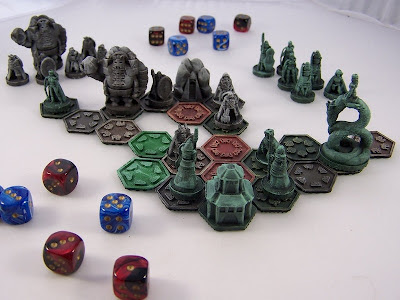What is a 3D Printer?
So what is a 3D printer? Well the clue is really in the name, imagine your typical printer that prints ink onto a flat piece of paper. Replace the ink with molten plastic and make the printer tray move up and down and you’re pretty close. A 3D printer creates models by depositing a layer of plastic in a way similar way to a traditional inkjet print head, the tray moves down (around a quarter of a mm) and then the next layer is added. The part is built up one layer at a time until you have a complete part. They’re typically used by engineers and product designers to prototype products and experiment with ideas but a new use has started to creep in: games.
Where 3D printing becomes interesting to us gamers is in the area of print and play games. Imagine buying a game on-line and downloaded all the files needed to make a complete game. Load these files into your 3D printer and wait for the parts to come out. No trekking down to the game store, no waiting impatiently for the post man to deliver your parcel. Such a thing already exists in the form of Pocket Tactics.
 |
| Pocket Tactics is the first of a new breed of 3D printed games |
For the world of miniature games this concept goes even further, you could make your own miniatures or scenery. The resolution of current technology means that highly detailed characters are going to be tricky but for large items like tanks and walkers then 3D printing at least creates a good starting point. Miniature manufacturers are already using this technology to make some of their larger figures. In No Quarter issue No. 43 Privateer press outline how they used 3D printers to make the masters for the new Mercenaries' Colossal miniature, well I say miniature this thing is HUGE. The colossus models don’t come cheap, so imagine being able to make one of these monstrous warjacks at home on your printer.
 |
| The Mercenaries Galleon Colossal Warjack was design using 3D printers |
Shut up and take my money!
Unfortunately we’re not quite at the point of having a 3D printer in every home. 3D printers are still very expensive items and are aimed at businesses rather than the home user. A typical professional 3D printer, like the Hewlett Packard Design Jet 3D is going to set you back around £15,000. This isn’t the full cost, 3D printers also need a washing machine that breaks down the support structure used to build up complicated pieces. The price also goes up to £20,000 for a two spool printer that allows you to make a part from two different coloured materials. Cheaper models do exist; the Makerbot Replicator for instance costs $1,750 (around £1,100) and can even make another version of itself.Using a 3D printer is not quite as simple as just pressing the print button. Although the software supplied with these machines is very intuitive you still have to understand how to orientate the part in the machine to get the best possible build. If you put the part in the wrong way you may get a poor finish or a part that collapses during the build.
 |
| The, ahem, robot that has caused Games Workshop's legal team so much bother. |
So should I get one?
Have you ever played a ‘print and play’ game? These are games where you download the 2D images print them onto card and you have a full game. Many games are nothing more than card and tokens that can easily be replicated at home with a printer but Print and Play games have never taken off in a big way. The reasons are because home-made media doesn’t look or feel as good as professionally made products. It’s also usually rather expensive and most gamers would prefer to just buy a finished product. I see this being the same for a 3D printer, most people aren’t going to take advantage of this because of the cost and the effort involved.Where 3D printers are more likely to take off are with the creative types and the miniature wargamers. If you’re the kind of person who makes their own custom box inserts or bespoke components then this will be right up your street. If you’re a wargamer it will give you the opportunity to design and build your own custom terrain that will be both impressive looking and hard wearing.













.png)


0 comments:
Post a Comment